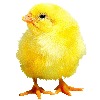|
|
 |
|
My fertility rate is around 80%, as good as it will ever be, and I hatch with a Little Giant Still
Air Incubator, a low cost styrafoam incubator that I have never had major problems with.
Hen Hatching Chicks
There are a few simple rules for attempting to hen hatch chicks. Do not take the eggs (obvious hu?)
Do not disturb the hen or touch the eggs, she will be very protective. ONLY use a cage with kiln dried pine or carefresh
bedding, avaliable from any pet store. NO CEDAR. For cleaning the cage, use a kitty litter scooper and scoop
up the bedding until you are about 5 inches away from her, or as close as you can get without her freaking out. Wear a glove,
some of my hens have drawn blood because I got too close. Do not touch the chicks for about 1 week, dont even clean the
cage. You can remove the empty egg shells is the hen lets you. Remove the male at about day 15, as the hen can get aggressive
towards him. He can be re-intoduced in about a week after hatching. A heat lamp isn't usually needed unless it is cold (under
50 degrees) or the hen isnt sitting, but putting one in won't do any damage.
|
 |
A chicken egg with 3 quail eggs for comparison
Mature female buttons lay about 1 egg per day, stopping in the colder months and when they are ill. Occasionally
they will sit on their own eggs, but if you would like to hatch eggs, an incubator is recomended. Button eggs are about the
size of a buttons head, and range in color from a light cream to an olive green. A button will sit when there are about 5-15
eggs. Normal incubation is about 15-22 days, with 16 being average but I tend to get babies on day 18 or 20. When
hatched, babies are about the size of a bumble bee and are walking and eating within a few hours.
|
 |
|
|
|
 |
Incubating Quail Eggs
If you plan on incubating eggs yourself, you will need to set your incubatior to about 101 degrees F for
a still air incubator, or 99 degrees F for an incubatior with a forced air fan. I suggest collecting eggs for about one week,
then putting them in the incubator all at once. DO NOT REMOVE the eggs once in the incubator. If you do not have an egg turner,
you will need to turn the eggs about 1/3 of a full rotation, 3 times a day. Stop turning on the 13th day. When the eggs hatch,
leave the chick in the incubator until it dries all the way, and if there are other chicks in the incubator, dont open it
until ALL chicks are dry and no eggs are partially open [wiggling is ok]. When you remove them from the incubator, be very
gentle and put them in a brooder.
I suggest keeping babies together. They are social animals and when seperated button quail make non-stop
cries to their mommy. If there is only one chick, put in an unfertilized egg for the firsr week, OR put in a surrogate hen.
For more info on surrogate hens, please visit: https://button-quail.tripod.com/surrogatequail/
|
 |
|
|
|
|
When the chicks are hatched, you have the option of using a brooder. If your hen hatched them, you may
need a brooder depending on the time of year and if you keep the birds inside or under an air vent. With all my chicks I use
a brooder. If the chicks get too hot they can always move to the other side of the brooder, but that is rarely a problem.
Have you seen the price of commercial brooders latley?
I dont know about you, but $200 is a bit over my budget. My brooder cost me $32 and It has never failed.
The brooder I use is a 10 gallon fish tank with CareFresh bedding on the bottom about 2 inches thick.
Bedding is very important to prevent splay-legged chicks. If you can not get carefresh, kiln dried pine pet bedding also works
well. I use a 60 watt heat lamp with a red bulb, and have this on all the time for the first 4 weeks. After the 4 week
period, I move the chicks into a permanent cage. For the chicks first winter I sometimes put a heatlamp on the cage to prevent
chilling.
For the brooder you can also use a cardboard box with a hole for the heatlamp cut in the top, but always
have somekind of bedding on the bottom to prevent splay-leg, and have water and food avaliable. For the water, I put a few
marbles in a lid with water so that the babies dont drown. I use another lid for food. The buttons will mature at 6-8
weeks, and start laying around this time.
|
|
|
 |

